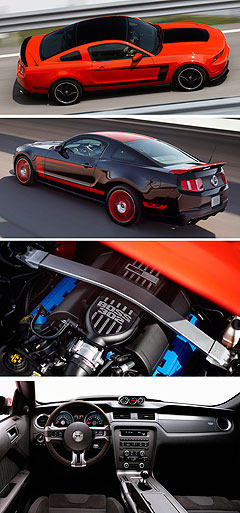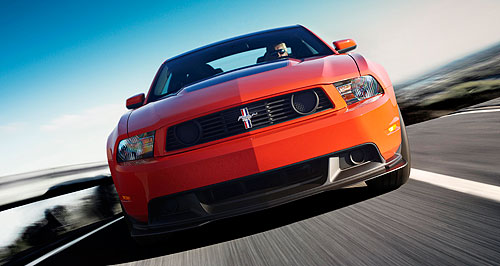Make / Model Search
Future models - Ford - FalconFoMoCo backs Falcon’s blown V8Top Boss: Ford's Mustang Boss 302 will get a 328kW naturally aspirated version of Ford's Coyote V8. Supercharged V8 for Ford’s upcoming XR8 and FPV range receives Blue Oval backing18 Aug 2010 THE Ford Motor Company has issued an indirect vote of confidence in the Australian-developed supercharged ‘Coyote’ V8 that is expected to power both Ford’s upcoming XR8 models, FPV’s upgraded 2010 V8 range and, potentially, next year’s born-again GT-HO performance flagship. Ford gave in-principle backing for a supercharged version of its all-new 5.0-litre V8 last week in a press release announcing its new 2012 Mustang Boss 302, which employs a high-performance (but still naturally aspirated) version of the Coyote V8 that increases power from 307kW to 328kW and revs to no less than 7500rpm. The more highly strung Boss V8, which will power next year’s 2012 Mustang Boss 302 in North America, is based on the flagship 2011 Mustang GT’s new DOHC 5.0-litre V8, but Ford says it could quite easily have been boosted by a mechanical supercharger. In Australia, that’s exactly what Ford and Prodrive engineers have developed for Ford Austrlia’s own 2010 XR8 and FPV’s 2010 V8 models. Indeed, the only reason given by FoMoCo for not fitting the Mustang Boss 302 with a supercharger, which it says would have been the easiest way to obtain ‘significantly’ more power from the standard 307kW Coyote V8, was because the original 1969 Mustang Boss 302 engine was not force-fed. “The Mustang team knew a supercharger would be the simplest way to extract significant power improvements from the new 5.0-liter V8,” says Ford, “but they elected not to pursue forced induction for the 2012 Boss to stay true to the original Boss 302 engine.” The 328kW Boss 302 engine, which will be built alongside the standard 307kW Coyote V8 at Ford’s Essex Engine Plant at Ontario in Canada, replaces the new 5.0-litre powerplant as the most powerful naturally aspirated production V8 engine Ford has ever produced, while Australia’s supercharged version is expected to power Ford’s first blown XR8 and FPV’s first forced-induction V8 models. As we’ve reported, the first all-supercharged V8 Ford line-up, which should be unveiled at the Bathurst 1000 in October, is expected to include a 315kW/550Nm XR8 sedan and ute, FPV GT models powered by a 335kW/600Nm V8 and, to mark the 40th anniversary of Allan Moffat winning Bathurst in a Falcon GTHO, perhaps even a circa-400kW/650Nm FPV GTHO.  Left: Ford Mustang Boss 302. Left: Ford Mustang Boss 302.Ford Australia has already announced details and sharp new pricing for its upgraded 2010 six-cylinder Falcon range, while FPV this week heralded the release of its upgraded turbocharged straight-six F6 model range. Soon after its Bathurst reveal, the homegrown force-fed 5.0-litre V8 will replace the 5.4-litre V8 – which coincidentally also wears the Boss name – that powers the outgoing XR8 and FPV’s V8 models but does not meet the tighter Euro 4 emission standard that came into effect on July 1. For the record, Ford engineers upped the power output of the engine in the 2012 Mustang Boss 302– a nameplate that signifies the 5.0-litre engine’s 302 cubic-inch displacement – to 328kW by increasing air flow and applying a range of engine durability measures. They include a revised composite intake system with shorter runners and fitting forged aluminium pistons, sinter-forged connecting rods, stronger CNC-machined alloy cylinder-heads, lighter valvetrain components including sodium-filled exhaust valves, race-spec crankshaft main and rod bearings, an engine oil-cooler, 5W50 full-synthetic oil, revised oil pan baffling to handle cornering loads of more than 1.0g and a race-inspired clutch for the short-throw six-speed manual transmission. Compared with the Mustang GT upon which it is based, the Boss 302 – which will also offer improved dynamics and braking courtesy of stiffer suspension and Brembo brakes – features a bigger front air intake, a revised grille blocking out the Mustang’s trademark central foglights, quad exhaust pipes and lighter 19-inch black alloy wheels. Ford’s newest pony car will also come with contrasting roof paintwork, a bonnet stripe and a 'C' stripe on the car's flanks, while a limited-edition 'Laguna Seca' version will also be available. A racetrack-oriented special that pays homage to the 1970 Trans-Am victory of the original Boss 302, it comes with even firmer springs and dampers, the option of deleting the rear seats in favour of a stabiliser bar that’s claimed to increase body rigidity, larger front and rear spoilers and Black or Ingot Silver paint with red accents. “The core group of engineers on the Boss 302 engine understands and respects the heritage of the name and the history behind the original engine,” said FoMoCo’s V8 engine program manager Mike Harrison. “The first Boss 302 was a specially built, free-breathing, high-revving small V8 that gave it certain desirable characteristics on a race course – and we capture that essence in the new engine. “Even though the production Boss engine is designed to be very close to a full race engine, it had to achieve the same vehicle durability signoff any other production engine requires. Then it went on to get the track durability test signoff too. “It’s really an engineering accomplishment that a Boss owner can thrash his car on the track and still expect the same outstanding reliability that the owner of a regular Mustang GT will enjoy.”  Read more16th of August 2010  FPV upgrades F6 rangeCleaner-burning Euro 4-compliant turbo engines for FPV’s upgraded F6 models11th of January 2010  Ford Australia confirms Coyote V8 for FalconFPV to supercharge new 5.0-litre V8 to give Ford a power boost to rival HSV29th of December 2009  Blue Oval’s next V8 emerges in new Mustang GTRedesigned all-alloy 5.0-litre V8 to power new Mustang GT – and FPV’s 2010 modelsAll future modelsMotor industry news |
Click to shareFord modelsResearch Ford All future modelsMotor industry news |


 Alfa Romeo
Alfa Romeo Abarth
Abarth Audi
Audi Aston Martin
Aston Martin BMW
BMW Bentley
Bentley Ferrari
Ferrari Chevrolet
Chevrolet Ford
Ford Fiat
Fiat GWM
GWM Foton
Foton Hyundai
Hyundai Honda
Honda Jaguar
Jaguar Isuzu
Isuzu Kia
Kia Jeep
Jeep Land Rover
Land Rover Lamborghini
Lamborghini Maserati
Maserati Lexus
Lexus McLaren
McLaren Mazda
Mazda Mercedes-Benz
Mercedes-Benz Mitsubishi
Mitsubishi Mini
Mini Peugeot
Peugeot Nissan
Nissan Ram
Ram Porsche
Porsche Rolls-Royce
Rolls-Royce Smart
Smart Skoda
Skoda Suzuki
Suzuki Subaru
Subaru Toyota
Toyota Tesla
Tesla Volvo
Volvo Zeekr
Zeekr







Facebook Twitter Instagram